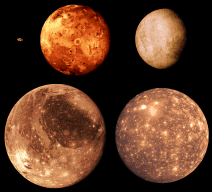

|
Astronomy 161:
An Introduction to Solar System Astronomy
Prof. Richard Pogge, MTWThF 9:30
|
Lecture 39:
The Moons of Jupiter

Key Ideas:
Jupiter has 63 known moons
4 Galilean Moons:
- Large (>3000 km), spherical & differentiated
- Io, Europa, Ganymede & Callisto.
- Io is volcanically active.
- Europa may have an ocean below the ice.
59 Small Moons:
- Small (<200 km), irregular, & undifferentiated
The 63 Moons of Jupiter
4 Galilean moons:
- Discovered by Galileo & Simon Marius in 1610
- Large (>3000 km across) & Spherical
- Differentiated interiors (like the Moon)
59 Small moons:
- Small (<200 km across)
- Irregular in shape (like Phobos & Deimos)
- Undifferentiated mixtures of rock & metals
- Probably captured asteroids or comet nuclei
4 Inner small moons are on regular orbits, the rest are outer moons
on irregular orbits, some retrograde. Interestingly, many of the irregular
outer moons come in dynamical "familes" of many moons with similar orbital
properties. This suggests that some of the captured moons are smaller pieces
of an originally larger "parent" body that was disrupted either by tides
or collisions during the capture process.
For more information on the current census of the Jovian moon system,
see Scott Sheppard's
Jupiter
Satellite Page at the University of Hawaii's
Institute for Astronomy.
The Galilean Moons
Order: Io Europa Ganymede Callisto (I Eat Green Cows)
Large, mostly rocky spherical moons.
All follow roughly circular orbits in the same direction
around Jupiter:
Orbital Periods:
- Io: 1.8 days
- Europa: 3.6 days (exactly 2 times Io's period!)
- Ganymede: 7.2 days (exactly 4 times Io's period!)
- Callisto: 16.7 days
The inner 3 Galilean moons are in a 1:2:4 orbital resonance and evolve
together. Callisto is almost part of this, and will eventually get
locked into a resonance with 8 times Io's orbit.
Volcanically Active Io
Io is the innermost Galilean moon. Io has a hot, molten
interior:
- Feels a strong tidal pull from Jupiter, plus an
additional tug from Europa every 2 orbits.
- Heats the interior, melting silicates & sulfur.
Results in active volcanoes:
- Active eruptions & pools of molten sulfur
Io is the most volcanically active world in the Solar System.
Smooth Europa
Europa is the smallest of the Galilean moons. It has an icy
surface covering a large rocky core:
- The surface is very smooth and young.
- Icy surface is fractured into rafts & floes a few
kilometers across, like in the Arctic.
- Water geysering to the surface through the cracks has
repaved it.
- Does Europa have liquid water under the ice?
What is under Europa's ice? Two ideas:
- 100-200 km of ice surrounding the rocky core.
- Thin ice crust over a 150 km thick water ocean.
Will require a lander or an orbiter with radar to probe
beneath the ice.
If there is liquid water, is there life?
- It's fun to speculate, but there is no data one way
or another at present.
Grooved Ganymede
Ganymede is the largest of the Galilean moons, and the largest
moon in the Solar System.
- 400 km larger than Mercury, but less than half its mass
(mean density is only 1.9 g/cc)
- This low density suggests it has a thick ice mantle over
a rocky core.
Covered with unique grooved terrain:
- Grooves are 10 km wide and 300 m deep.
- Formed <2Gyr ago based on the number of impact craters
seen on top of them.
Nobody has yet come up with an explanation for the grooved
terrain, beyond speculating that they are stretch marks on the
icy crust.
Cratered Callisto
Callisto is the outermost of the Galilean moons. It has a
surface consists of dirty ice pocked with numerous impact
craters.
- Heavy cratering indicates that Callisto is geologically
inactive, and has been so ~4 Gyr
- Craters are bright - revealing clean ice below.
- Its mean density is 1.8 g/cc, suggesting that the ice is
layered on a small rocky core.
Of all of the Galilean moons, Callisto shows the least signs
of geological activity.
Moons in Comparison
Io & Europa are mostly rock:
- Mean densities of 3.5 & 3.0 g/cc respectively
- Io: rocky lithosphere, molten mantle & active
volcanoes
- Europa: icy lithosphere & rocky core.
Ganymede & Callisto are mixed ice & rock:
- Mean densities of 1.9 & 1.8 g/cc, respectively
- Deep ice mantles over rocky/icy cores.
- Both are less geologically active.
Interior Heat
In the terrestrial planets, interior heat is determined by the
planet's size:
- Large Earth & Venus have hot interiors
- Smaller Mercury & Mars have cold interiors
In the Galilean moons, interior heat is determined by
proximity to Jupiter
- Innermost Io is hottest, outermost Callisto is coldest
- The energy source is tidal heating from Jupiter.
Readings in Universe:
Chapter 15-1 through 15-7
Return to [
Unit 6 Index
|
Astronomy 161 Main Page
]
Updated: 2006 November 19
Copyright © Richard W. Pogge, All Rights
Reserved.
